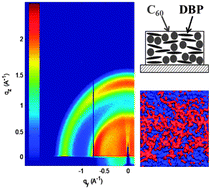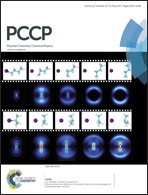Morphology, molecular stacking, dynamics and device performance correlations of vacuum-deposited small-molecule organic solar cells†
Abstract
The “all carbon” organic solar cells (OSCs) based on the homocyclic molecule tetraphenyldibenzoperiflanthene (DBP) as a donor and C60 as an acceptor were comprehensively characterized. The optimized planar-mixed heterojunction device with a DBP:C60 mixture ratio of DBP : C60 (1 : 2) exhibited a power conversion efficiency of 4.47%. To understand why DBP possesses such advantageous characteristics, the correlations of the morphology, molecular stacking, carrier dynamics and performance of DBP:fullerene-based devices have been systematically studied. First, the face-on stacked DBP molecules could enhance both the absorption of light and the charge carrier mobility. Second, DBP : C60 (1 : 2) thin films with optimized domain sizes and partially interconnected acceptor grains led to the most balanced carrier mobility and the lowest bimolecular recombination in devices. Finally, the DBP molecules were found to stack closely using grazing incidence wide-angle X-ray scattering measurements, with a π–π stacking spacing of 4.58 Å, indicating an effective molecular orbital overlap in DBP. The study not only reveals the promising characteristics of DBP as a donor in OSCs but the clear correlations of the thin-film nano-morphology, molecular stacking, carrier mobility and charge recombination found here could also provide insights into the characterization methodology and optimization of the small molecule OSCs.


 Please wait while we load your content...
Please wait while we load your content...